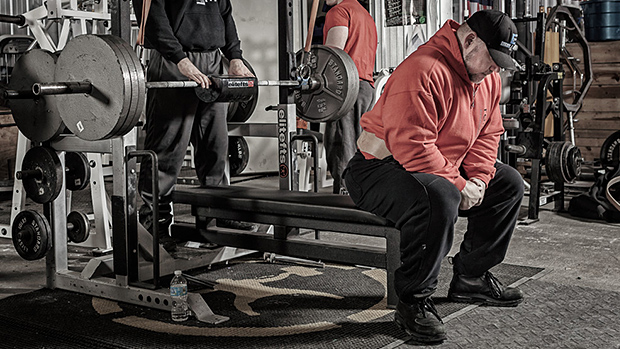Here's what you need to know...
- It's not what you can do in a set, it's what you can do in a workout. It's not what you can do in a workout, it's what you can do in a training cycle.
- If you're interested in maximal strength, tension is the name of the game. That can mean lifting a very heavy weight as fast as you can, lifting a moderately heavy weight as fast as you can, or ideally, both.
- If your main goal is strength, you should terminate any given set just short of technical breakdown, or for stable lifters, always leave one solid rep in the tank for any given set.
- If your main goal is hypertrophy, you should use a wide range of reps, from as few as 1 to as many of 30. This can be done by pyramiding up to a few heavy sets, followed by a few higher-rep "back off" sets with lighter weights.
- Most trainees need to address both strength and hypertrophy in their training, regardless of what they consider their primary goal to be. The "sweet spot" between these two adaptations seems to be 5-8 reps per set.
- Training to failure is only advisable for technically stable athletes on their last set. Blowing your wad on your first set will limit the overall amount of volume you'd otherwise be able to rack up.
Whenever you're doing a set, there are only two real decisions you need to make:
- How many reps should I do?
- How close to failure should I go?
Aside from exercise selection and training frequency, these are possibly the two most important decisions you'll need to make in order to obtain optimal results from your training. To answer these questions, you'll in turn need to ask two additional questions:
- What's my goal?
- How many total sets am I going to do for that exercise?
Let's Break It Down
Okay, now let's lay down some foundational context. In traditional bodybuilding circles, low (1-3) reps with heavy (85% and up) weights leads to maximal strength development as the primary adaptation. Lighter weights - say sets of between 8-12 reps performed to or near failure - are usually touted as best for hypertrophy or muscle growth purposes. If you're looking for the "sweet spot" between these two adaptations, you'd do sets of between 5-8 reps.
Now, that advice isn't so much wrong as it is incomplete. First of all, while performing (for example) 3 sets of 3 with a heavy load would in fact lead to maximal strength development almost to the exclusion of a hypertrophy adaptation, the lack of hypertrophy development you'd see from habitually performing 3x3 can't be blamed on the decision to do 3 reps per set, but rather, to the relatively low total volume of 9 repetitions.
If you instead performed 10x3 (as T Nation contributor Chad Waterbury often recommends), you'd have 30 total reps under your belt, which should provide sufficient mechanical work to trigger new muscle growth.
Another consideration is that there are (according to hypertrophy specialist Brad Schoenfeld) at least three different mechanisms leading to hypertrophy. In a recent interview Shoenfeld posited that:
"...there's evidence that there are three main mechanisms that mediate muscle growth: mechanical tension, metabolic stress, and muscle damage. My view is that there is a 'sweet spot' where these effects can be optimized, and that this would equate to somewhere in the 6-12 rep range. I also hypothesize that the response will be quite different between individuals so some might respond best at somewhat higher or lower intensities."
This means that if hypertrophy is your desired end game, you need to regularly perform a wide range of repetition brackets, and it also means that your total volume must be both sufficient and sustainable. By "sufficient" I mean the volume for a given exercise and/or workout must be enough to stimulate new growth.
And to understand what I mean by "sustainable" consider the following hypothetical: Let's say one day you find some amazing new pre-workout supplement that jacks you up to a frothing frenzy. On top of that, you meet up with two of your most motivated training partners. The three of you get into a competitive squatting session that leaves you completely throttled. More is better, right? Pain is weakness leaving the body, right? Well, not exactly, because now you're not gonna be able to train legs for about 10 days, which means that despite your gym-hero antics in the squat rack, you've now unintentionally reduced your total weekly training volume.
The trouble is, it's what you can do long-term that really impacts your progress, not what you can do once in a while. So regardless of what your goal is, take the 30,000-foot view: It's not what you can do in a set, it's what you can do in a workout. It's not what you can do in a workout, it's what you can do in a training cycle. And so on and so forth.

The 3 Stages of Technical Proficiency
But there's another consideration we need to factor in to the "How close should I take a set to failure?" aspect of this discussion. In terms of technical proficiency, there are three stages of technical proficiency:
1. Incompetent
You don't know how to, and/or aren't able to perform the exercise properly. At this stage, you haven't yet earned the right to do "sets and reps" per se. Instead, what you need is practice. So if for example you're incompetent on squats, you practice the squat, at the same time using simpler exercises such as leg extensions, leg curls, and/or back extensions to achieve your strength and hypertrophy goals until your squat gets to a point to where you can train it more aggressively./p>
2. Unstable
With moderate loads, your mechanics are fine, but once you reach a certain weight on the bar, you start falling apart./p>
3. Stable
Your technique - while not necessarily perfect - looks the same no matter how much weight you're attempting. For example, if you can't stand back up with a heavy squat; your low back doesn't round; your knees don't cave in; you just fail.
I bring these competency levels to your attention simply to point out that if you're at the "unstable" level, you should always stop each set short of technical failure. If you're still at the "incompetent" level, this article doesn't even apply to you - or at least it doesn't apply to the exercises you can't perform properly. Only when you reach the "stable" level of proficiency do you even need to worry about when to terminate a set.
With those foundational preliminaries out of the way, let's proceed to a few practical scenarios:
My main goal is strength, so how many reps per set should I do?
If you're interested in maximal strength, tension is the name of the game. That can mean lifting a very heavy weight as fast as you can (even though it won't actually move fast), lifting a moderately heavy weight as fast as you can, or ideally, both. For both methods, you'll want to use low (1-3 per set) reps. This sounds simple enough, but there's a confounding factor that you'll need to consider: Strength is not only dependent on neural factors (which are trained using the two methods I just listed), but also the thickness of your muscle fibers. This means that most strength athletes also need concurrent hypertrophy training.
My main goal is strength. How close to failure should I go on any particular set?
Ideally, you'd know your maximum rep speed for any given weight, and then terminate any given set once that speed erodes to any significant degree. But since most people don't have access to the equipment needed to measure bar speed, I'd recommend terminating any given set just short of technical breakdown, or for stable lifters, always leave one solid rep in the tank for any given set. This helps to ensure safety, and it also keeps psychological arousal to a minimum, which facilitates better recovery from session to session.
My main goal is hypertrophy, so how many reps per set should I do?
According to the current research on the subject as well as my coaching observations, you should use a wide range of reps, from as few as 1 to as many of 30. These can be done either sequentially (meaning short phases of low reps interspersed with short phases of higher reps), or concurrently, by pyramiding up to a few heavy sets, followed by a few higher-rep "back off" sets with lighter weights. The latter is my choice.
My main goal is hypertrophy. How close to failure should I go on any particular set?
A: Intuition suggests that you should go balls-out each and every set. But doing so isn't ideal for the long haul. Imagine that your max reps for pull-ups is 10. Not 11 mind you, but 10. So you decide to go for broke on the first set, and you barely get 10 reps. You're totally shot. But you man up for your second set, and with a huge effort, you manage 7, which felt every bit as hard as the first set. You almost decide to call it a day, but after about several minutes of fighting your lower angels, you pony up for set 3, where you barely manage 5 reps. So you totaled 22 reps.
Now what if instead, you did 7 reps on your first set? I'd bet that you could repeat that performance for an additional 3 sets for a total of 28 reps. And I bet 4x7 would actually hurt a lot less, too. Most importantly, over weeks and months, those extra 6 reps would really start to pay off in terms of new protein synthesis. Again, we tend to be myopic. It's the long term that matters.
So What Have We Learned?
- The ideal number of reps you do in a particular set mostly depends on your primary training objective. How close you come to failure on any given set however, depends mostly on your technical proficiency and whether or not it's your last set for the exercise you're working.
- It's the sustainability of training that really pays the bills, not how badass you were on that one epic day last November. Sure, intensity is key, but only the highest level of intensity you can maintain.
- Most trainees need to address both strength and hypertrophy in their training, regardless of what they consider their primary goal to be. The sweet spot between these two adaptations seems to be 5-8 reps per set.
- Training to failure is only advisable for technically stable athletes on their last set. Blowing your wad on your first set will limit the overall amount of volume you'd otherwise be able to rack up.



